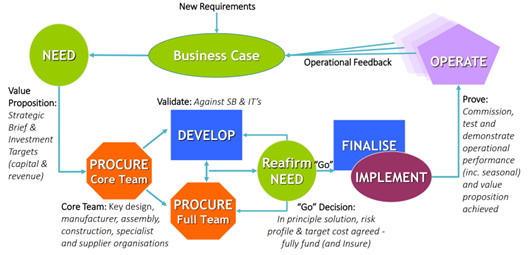Over the last few Collaborative Working Mentors meetings, the group has been working hard to build upon the work they started on Improving the Traditional Process.
Over the course of these meetings the process has been built upon and developed to take the model from this:

to this

Though this model has been through numerous iterations, in the most recent meeting, on 19th April, the group decided it is now in a format that we are able to share.
What Benefits Does Collaborative Alliancing Provide?
There are a number of benefits that could be gained by applying the Collaborative Alliancing model and these effectively sum up the reasoning behind moving on from the traditional process and engaging in a more collaborative approach.
These are some of the potential benefits:
Better risk sharing
Better due diligence
Less adversarial environments
Earlier involvement
Faster
Cheaper
Repeatable
Value focused
Better outcomes
Reduced duplication
Better mental health
Utilises supplier innovation
Maximises experience and knowledge
Playbook alignment
Enables effective technical quality management
Fewer defects
What is collaboration?
‘The process of two of more people/organisations intentionally working together to achieve a specific shared goal.’
As part of our most recent Collaborative Working Mentors meeting, we were lucky to be joined by Howard Betts, Director at Executive Development, to share further insight into collaboration, as well as some findings from his research into collaboration within construction.

Howard explained that collaboration should enable all parties to get something out of the process that could not have been achieved on their own. Many people believe that collaboration takes place intuitively, but this is not the case. This process needs to be engaged in intentionally, which means there is actually far less true collaboration taking place than we realise.
When taking part in a collaborative process, there are 5 phases that those involved will traverse:
- Confrontational
- Compliant
- Cooperative
- Collaborative
- Co-creative
The biggest issue with collaboration is that most people hold a negative attitude towards it, making it difficult for them to realise the potential benefits. In his research, Howard found that when asked for reasons ‘for’ and ‘against’ collaboration, people generally came up with more reasons against collaborating.
The big question is how do we overcome the challenge of people’s negative beliefs/ attitudes/ behaviours towards collaboration?
These challenges need to be tackled before collaboration can engaged in effectively. People need to believe collaboration can work to take the leap of faith and give it a go.
This is the challenge that the Collaborative Working Mentors will need to tackle in encouraging people to engage in the Collaborative Alliancing model. This model only works if the culture around collaboration is in place. This does require individuals to be on board, but also requires companies to change their culture around collaboration.
tackle in encouraging people to engage in the Collaborative Alliancing model. This model only works if the culture around collaboration is in place. This does require individuals to be on board, but also requires companies to change their culture around collaboration.

Next Steps
Within the meeting, a discussion took place around the next steps which were identified as
- Identify the value this model brings to provide reason for users to take it up.
- Identify who the stakeholders are at each stage of the model. We need to see where there may be pitfalls and explore what would make the change more likely to stick- who do we need on board to help put these changes into place?
- Map Construction Playbook onto the model to show how it meets requirements.
- Identify parallels and links between the model and the Value Toolkit and show how it can act as an enabler.


